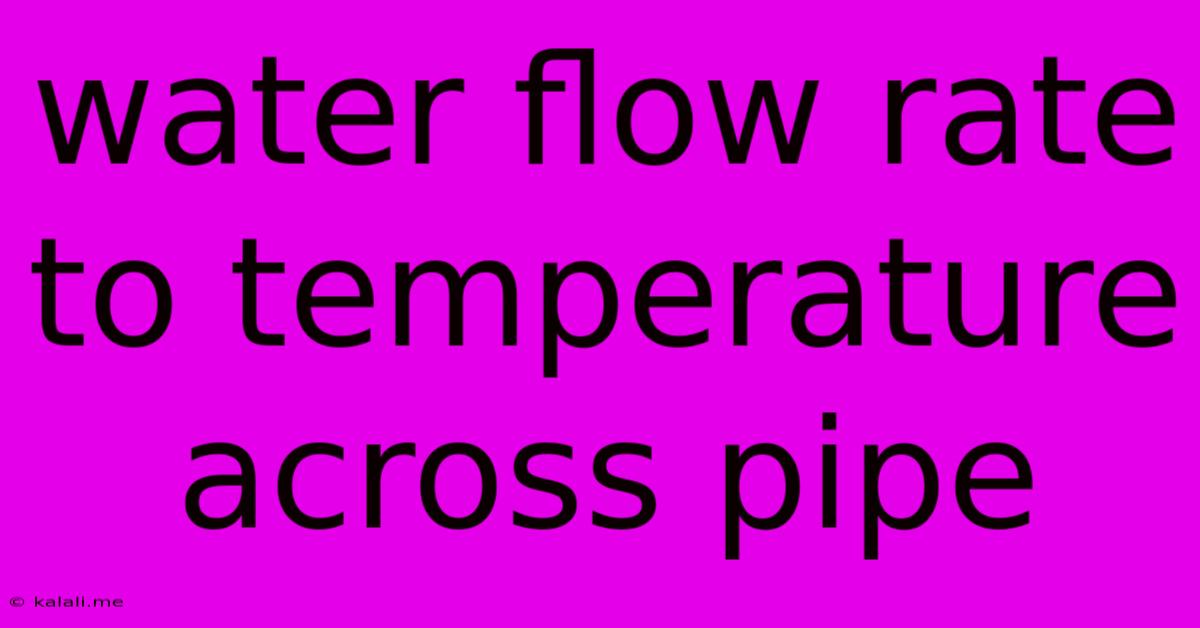Water Flow Rate To Temperature Across Pipe
Kalali
Jun 06, 2025 · 3 min read

Table of Contents
Understanding the Relationship Between Water Flow Rate and Temperature Across a Pipe
The relationship between water flow rate and temperature across a pipe is a crucial consideration in various engineering and industrial applications, from heating and cooling systems to chemical processing. Understanding this relationship is essential for efficient system design and optimal performance. This article delves into the physics behind this interaction, exploring the key factors influencing temperature changes along a pipe carrying flowing water.
Understanding Convective Heat Transfer
The primary mechanism governing temperature changes in a flowing fluid within a pipe is convective heat transfer. This process involves the transfer of thermal energy between the fluid and the pipe's surface. Several factors influence the rate of this heat transfer:
-
Flow Rate: A higher flow rate means more water molecules are interacting with the pipe surface per unit time. This leads to a more effective transfer of heat, either from the pipe to the water (heating) or from the water to the pipe (cooling). A slower flow rate allows for greater heat exchange at each point, potentially resulting in a larger temperature change across the pipe length.
-
Pipe Material and Dimensions: The thermal conductivity of the pipe material plays a significant role. Materials with high thermal conductivity, such as copper or aluminum, facilitate faster heat transfer compared to materials with lower conductivity, like plastic. The pipe's diameter and length also influence the surface area available for heat exchange, impacting the overall temperature change. A larger diameter or longer pipe provides a greater surface area, increasing the potential for heat transfer.
-
Fluid Properties: The specific heat capacity of water dictates how much energy is required to change its temperature. The higher the specific heat capacity, the more energy is needed for a given temperature increase. Viscosity also impacts the flow characteristics, influencing heat transfer efficiency.
-
Temperature Difference: The temperature gradient between the water and the pipe's surface is the driving force for heat transfer. A larger temperature difference results in a faster rate of heat transfer. This is governed by the principles of thermodynamics and expressed through equations involving heat transfer coefficients and thermal resistances.
-
Insulation: The presence of insulation around the pipe significantly reduces heat transfer to or from the surroundings. This maintains a more stable water temperature along the pipe's length.
Mathematical Modeling and Practical Applications
The relationship between flow rate and temperature can be modeled using various equations, depending on the complexity of the system and assumptions made. Simple models might employ basic heat transfer equations, while more sophisticated models incorporate computational fluid dynamics (CFD) for accurate simulations.
Practical applications are numerous:
-
HVAC Systems: Accurate prediction of water temperature changes in heating and cooling systems is crucial for efficient building climate control.
-
Process Engineering: In chemical and other industrial processes, controlling the temperature of flowing fluids is essential for maintaining reaction rates and product quality.
-
District Heating Networks: Understanding the temperature dynamics in large-scale district heating networks is crucial for optimizing energy distribution and minimizing heat losses.
-
Oil and Gas Industry: Maintaining optimal temperatures in pipelines transporting oil or other fluids is critical for preventing issues such as viscosity changes and pipeline blockage.
Conclusion
The relationship between water flow rate and temperature across a pipe is a complex interplay of several factors. Accurate modeling and understanding of these interactions are vital for the efficient design and operation of countless systems across various industries. Further research and advancements in computational methods continuously refine our ability to predict and control this fundamental relationship. By carefully considering the factors discussed, engineers can optimize systems for maximum efficiency and minimize energy losses.
Latest Posts
Latest Posts
-
Phallic Or Concerned With Male Virility
Jun 06, 2025
-
Baahubali 2 Is All Flashbacks Of Amahendra Bahubali
Jun 06, 2025
-
How To Toenail Deck Both Sides
Jun 06, 2025
-
Is Soft Water Bad For Plants
Jun 06, 2025
-
Fallout 4 How To Attach Wires
Jun 06, 2025
Related Post
Thank you for visiting our website which covers about Water Flow Rate To Temperature Across Pipe . We hope the information provided has been useful to you. Feel free to contact us if you have any questions or need further assistance. See you next time and don't miss to bookmark.